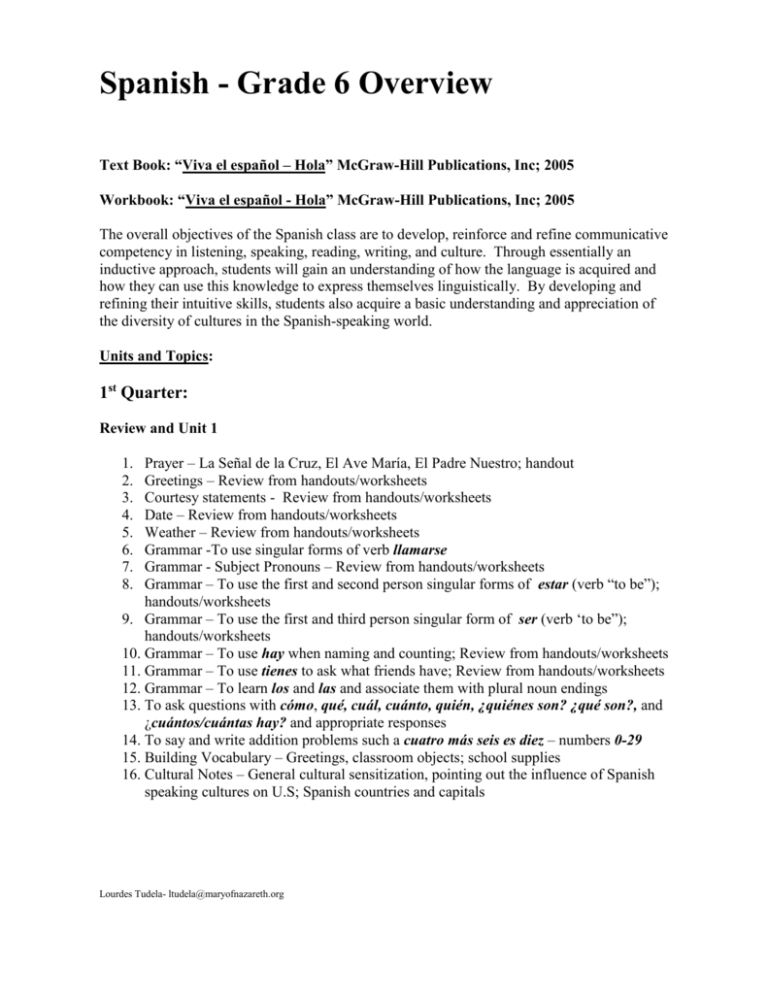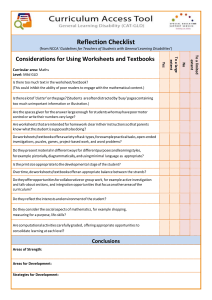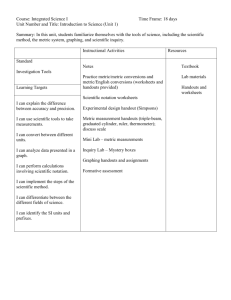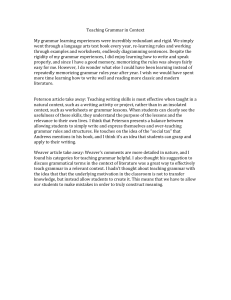Grade 6 Expectations - Mary of Nazareth School
advertisement

Spanish - Grade 6 Overview Text Book: “Viva el español – Hola” McGraw-Hill Publications, Inc; 2005 Workbook: “Viva el español - Hola” McGraw-Hill Publications, Inc; 2005 The overall objectives of the Spanish class are to develop, reinforce and refine communicative competency in listening, speaking, reading, writing, and culture. Through essentially an inductive approach, students will gain an understanding of how the language is acquired and how they can use this knowledge to express themselves linguistically. By developing and refining their intuitive skills, students also acquire a basic understanding and appreciation of the diversity of cultures in the Spanish-speaking world. Units and Topics: 1st Quarter: Review and Unit 1 Prayer – La Señal de la Cruz, El Ave María, El Padre Nuestro; handout Greetings – Review from handouts/worksheets Courtesy statements - Review from handouts/worksheets Date – Review from handouts/worksheets Weather – Review from handouts/worksheets Grammar -To use singular forms of verb llamarse Grammar - Subject Pronouns – Review from handouts/worksheets Grammar – To use the first and second person singular forms of estar (verb “to be”); handouts/worksheets 9. Grammar – To use the first and third person singular form of ser (verb ‘to be”); handouts/worksheets 10. Grammar – To use hay when naming and counting; Review from handouts/worksheets 11. Grammar – To use tienes to ask what friends have; Review from handouts/worksheets 12. Grammar – To learn los and las and associate them with plural noun endings 13. To ask questions with cómo, qué, cuál, cuánto, quién, ¿quiénes son? ¿qué son?, and ¿cuántos/cuántas hay? and appropriate responses 14. To say and write addition problems such a cuatro más seis es diez – numbers 0-29 15. Building Vocabulary – Greetings, classroom objects; school supplies 16. Cultural Notes – General cultural sensitization, pointing out the influence of Spanish speaking cultures on U.S; Spanish countries and capitals 1. 2. 3. 4. 5. 6. 7. 8. Lourdes Tudela- ltudela@maryofnazareth.org Unit 2 1. Prayer – La Señal de la Cruz, El Ave María, El Padre Nuestro 2. Greetings – Review from handouts/worksheets 3. Courtesy statements - Review from handouts/worksheets 4. Date – Review from handouts/worksheets 5. Weather – Review from handouts/worksheets 6. Grammar - Subject Pronouns – Review from handouts/worksheets 7. Grammar – To use singular and plural endings on adjectives 8. Grammar – To use masculine and feminine endings on adjectives 9. Grammar – To use indefinite articles when talking in generalities 10. Grammar – To use definite articles when talking about specific things or people 11. Grammar – To use descriptive words such as pequeño, largo, and flaco 12. Grammar – To ask questions with ¿de qué color es…? ¿Cómo son…? ¿Cómo es…? 13. Building Vocabulary – Colors; animals 14. Cultural Notes – Describing animals around the world, especially in Latin America; los países y sus capitales, El Día de La Raza Unit 3: 1. Prayer – La Señal de la Cruz, El Ave María, El Padre Nuestro 2. Greetings – Review from handouts/worksheets 3. Courtesy statements - Review from handouts/worksheets 4. Date – Review from handouts/worksheets 5. Weather – Review from handouts/worksheets 6. Grammar - Subject Pronouns – Review from handouts/worksheets 7. Grammar – To use the contraction al with masculine place names 8. Grammar – To use the singular present tense forms of ir 9. Grammar – To use singular and plural definite articles with days of the week 10. Grammar – To use the interrogative ¿Cuándo? 11. Building Vocabulary – Days of the week and related vocabulary such as hoy and el fin de semana; to name common places in town, such as el cine, la escuela, and el parque; to name numbers 0-49 12. Cultural Notes – Family and school activities and places in town in Spanish speaking countries; differences in the English and Spanish calendars 2nd Quarter: Unit 4 1. 2. 3. 4. 5. 6. 7. Prayer – La Señal de la Cruz, El Ave María, El Padre Nuestro, Gloria Greetings – Review from handouts/worksheets Courtesy statements - Review from handouts/worksheets Date – Review from handouts/worksheets Weather – Review from handouts/worksheets Grammar - Subject Pronouns – Review from handouts/worksheets Grammar – To ask questions using ¿Adónde vas? and, ¿Qué vas a hacer? Lourdes Tudela- ltudela@maryofnazareth.org 8. Grammar – To respond to questions using voy a… 9. Grammar – To use ir + a + infinitive to talk about future activities 10. Grammar – To talk about actions using singular subjects and regular –ar verbs 11. Building Vocabulary – To name school classes and locations, such as el gimnasio, la clase de computadoras, and la clase de música; to use verbs related to classroom activities, such as pintar, estudiar, and usar la computadora; to use words to describe performance, such as muy bien and mucho; to name numbers 50-69 12. Cultural Notes – Activities of students in Spanish-speaking countries, as well as on the arts and sports; Spanish countries and capitals, El Día de los Muertos, El Día de Acción de Gracias Unit 5 Prayer – La Señal de la Cruz, El Ave María, El Padre Nuestro Greetings – Review from handouts/worksheets Courtesy statements - Review from handouts/worksheets Date – Review from handouts/worksheets Weather – Review from handouts/worksheets Grammar - Subject Pronouns – Review from handouts/worksheets Grammar – To ask questions using ¿Qué estación…? ¿Hace fresco/frio/calor?, and ¿Qué tiempo hace? 8. Grammar – To use the pronouns me, te, and le in sentences with the verb gustar 9. Grammar – To use the verb gustar with singular subjects 10. Grammar – To place descriptive words correctly within sentences 11. Grammar – To abbreviate sentences by replacing the noun with the definite article el or la plus a descriptive word 12. Grammar – To use the personal a before people’s names in sentences with gustar 13. Building Vocabulary – To name the seasons, to describe different weather conditions, to use descriptive words related to temperature 14. Cultural Notes – How Spanish-speaking countries cope with and describe weather conditions; La Navidad, El Año Nuevo 1. 2. 3. 4. 5. 6. 7. Unit 6 Grammar – To use singular pronouns to clarify or emphasize the subject of an action Grammar – To write questions, using pronouns for clarity and emphasis Grammar – To write complete sentences Grammar – To use también and tampoco in the correct situations Building Vocabulary – Months of the year and related activities; adverbs, such as siempre, a veces, and nunca to describe frequency; numbers 70-89, inclusive 6. Cultural Notes – Focus is on dates and holidays, especially in Spanish-speaking countries; La Navidad, El Año Nuevo 1. 2. 3. 4. 5. Lourdes Tudela- ltudela@maryofnazareth.org 3rd Quarter: Unit 7 Prayer – La Señal de la Cruz, El Ave María, El Padre Nuestro, Gloria Greetings – Review from handouts/worksheets Courtesy statements - Review from handouts/worksheets Date – Review from handouts/worksheets Weather – Review from handouts/worksheets Grammar - Subject Pronouns – Review from handouts/worksheets Grammar – To form questions and affirmative and negative statements using tener expressions such as ¿Tienes frío? ¿Tienes prisa? Tengo hambre and, No tengo calor 8. Grammar - To use tener to express having feelings and possessions: Tengo miedo; Tengo dos libros 9. Grammar - To understand the difference between tú and usted and use correct pronoun-verb agreement 10. Building Vocabulary – To describe yourself and how you feel using hambre, sueño, and años; numbers 90-100 11. Cultural Note – The way people celebrate birthdays, especially in Spanish Speaking countries; Spanish countries and capitals; Día de San Valentín 1. 2. 3. 4. 5. 6. 7. Unit 8 Prayer – La Señal de la Cruz, El Ave María, El Padre Nuestro, Gloria Greetings – Review from handouts/worksheets Courtesy statements - Review from handouts/worksheets Date – Review from handouts/worksheets Weather – Review from handouts/worksheets Grammar - Subject Pronouns – Review from handouts/worksheets Grammar – To use singular and plural forms of ser to tell time on, after, and before the hour 8. Grammar – To use interrogatives such as ¿Qué hora es? ¿A qué hora? ¿Cuánto tiempo hay? 9. Grammar – To use por and de in time expressions 10. Building Vocabulary – To use words and expressions for measuring time; to name different times of day; to use expressions for telling time 11. Cultural Note – Concepts Spanish speakers use to describe and measure time; Spanish countries and capitals 1. 2. 3. 4. 5. 6. 7. Lourdes Tudela- ltudela@maryofnazareth.org 4th Quarter Unit 9 1. Prayer – La Señal de la Cruz, El Ave María, El Padre Nuestro, Gloria 2. Greetings – Review from handouts/worksheets 3. Courtesy statements - Review from handouts/worksheets 4. Date – Review from handouts/worksheets 5. Weather – Review from handouts/worksheets 6. Grammar - Subject Pronouns – Review from handouts/worksheets 7. Grammar – To ask questions with ¿Por qué? and ¿Por qué no? 8. Grammar – To use gustar in the singular and plural 9. Grammar – To make negative statements 10. Grammar – To use singular forms of the –er and –ir verbs aprender, comprender, leer, and escribir 11. Building Vocabulary – To name various school subjects, such as el inglés, las matemáticas, la educación física, etc. 12. To describe with adjectives, such as aburrido, fácil, fantástico, etc. 13. Cultural Notes – School life in Spanish-speaking countries; La Semana Santa, La Pascua Unit 10 1. Prayer – La Señal de la Cruz, El Ave María, El Padre Nuestro, Gloria 2. Greetings – Review from handouts/worksheets 3. Courtesy statements - Review from handouts/worksheets 4. Date – Review from handouts/worksheets 5. Weather – Review from handouts/worksheets 6. Grammar - Subject Pronouns – Review from handouts/worksheets 7. Grammar – To ask and answer questions with ¿Quién es…? and ¿Cómo se llama…? 8. Grammar – To understand the meaning of diminutives 9. Grammar –To ask and answer questions with ¿De quién es…? 10. Grammar - To use the possessive adjectives mi, tu, su, and their plural forms 11. Grammar - To describe people using words such as alto, bajo, and simpático 12. Building Vocabulary – To name family members; to show possession and describe people 13. Cultural Note – Families and family relationships in Spanish-speaking countries Lourdes Tudela- ltudela@maryofnazareth.org





![[Zadajte text] COURSE SYLLABUS: GRAMMAR Teacher: Katarina](http://s3.studylib.net/store/data/007224186_2-7ffa56f530823921bba51bdfa9cd702d-300x300.png)

